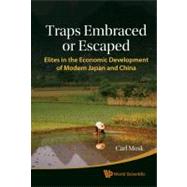
What is included with this book?
| Preface | p. vii |
| A Note on Transcription | p. ix |
| List of Charts and Tables | p. xv |
| Introduction | |
| The Argument | p. 3 |
| Elites and Traps | p. 17 |
| The Fundamental Transformation of Labor Surplus Economies | p. 17 |
| Elites Competing and cooperating | p. 23 |
| Traps | p. 33 |
| The Erosion of Elite Status | p. 39 |
| Co-evolution | p. 41 |
| Appendix: The Fundamental Growth Equation | p. 43 |
| Coping with the Western Challenge, 1840-1911 | |
| Qing China, 1840-1911 | p. 47 |
| Elites in Qing China | p. 47 |
| The western Challenge | p. 56 |
| Qing Response | p. 62 |
| Tokugawa and Meiji Japan | p. 70 |
| In Two Mirros | p. 70 |
| Elites in Tokugawa Japan | p. 72 |
| The Meiji Restoration | p. 79 |
| Traps, 1910-1955 | |
| Growth Acceleration in Japan, 1910-1938 | p. 89 |
| Agriculture and the Decline of a Rural Elite | p. 89 |
| Infrastructure and Urbanization | p. 92 |
| Manufacturing | p. 95 |
| The Demographic Transition Commences | p. 97 |
| The Disintegration of the fukoku kyohei Consensus | p. 100 |
| Agriculture and Industrialization in Republican China, 1911-1935 | p. 108 |
| A Divided Elite | p. 108 |
| Landlordism and Surplus Labor in Rural China | p. 113 |
| Manufacturing Expansion in Shanghai and Manchuria | p. 116 |
| Regional Fissures | p. 119 |
| Militarism, 1930-1945 | p. 126 |
| A Changing Geopolitical Environment | p. 126 |
| Nationalism and Anti-Imperialism in China | p. 129 |
| Japan's Drive to Hegemony in Asia | p. 132 |
| Surrender | p. 136 |
| Consequences, 1945-2005 | |
| Elites in Decline | p. 143 |
| Elites Disappearing and Emerging in Japan, 1945-1960 | p. 143 |
| Elites Disappearing and Emerging in China, 1945-1960 | p. 147 |
| China in the Japanese Mirror: Similarities and Dissimilarities | p. 149 |
| Miracle Growth and Its Aftermath in japan | p. 156 |
| The Main Characteristics of Miracle Growth | p. 156 |
| Productivity Gain in Agriculture | p. 162 |
| Productivity Gain in Manufacturing | p. 163 |
| Struggling with the Legacy of Miracle Growth, 1975-2005 | p. 169 |
| Commond and Control and Its Aftermath in China | p. 176 |
| The Main Characteristics of Command and Control in China | p. 176 |
| Productivity Gain in Agriculture | p. 181 |
| Productivity Gain in Manufacturing | p. 185 |
| Struggling with the Legacy of the Command and Control Period | p. 187 |
| Conclusions | p. 191 |
| Statistical Appendix | p. 195 |
| Bibliography | p. 245 |
| Index | p. 255 |
| Table of Contents provided by Ingram. All Rights Reserved. |
The New copy of this book will include any supplemental materials advertised. Please check the title of the book to determine if it should include any access cards, study guides, lab manuals, CDs, etc.
The Used, Rental and eBook copies of this book are not guaranteed to include any supplemental materials. Typically, only the book itself is included. This is true even if the title states it includes any access cards, study guides, lab manuals, CDs, etc.